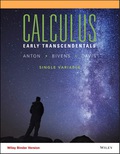
Concept explainers
Suppose that a mass m is an orbit about a mass M and that
Want to see the full answer?
Check out a sample textbook solution
Chapter 12 Solutions
EBK CALCULUS EARLY TRANSCENDENTALS SING
Additional Math Textbook Solutions
Elementary Statistics: Picturing the World (7th Edition)
University Calculus: Early Transcendentals (4th Edition)
Elementary Statistics (13th Edition)
A First Course in Probability (10th Edition)
College Algebra with Modeling & Visualization (5th Edition)
- Force Repeat Problem 43 for a 25.0-pound weight and a bench inclined at 12.5.arrow_forwardForces acting on moving objects (cars, airplanes, ships, etc.) require the engineer to know corresponding tangential and normal accelerations. In Probs. 35-38 find them, along with the velocity and speed. Sketch the path. Parabola r(t) = [t, t², 0]. Find v and a.arrow_forward2. d. C. b. Let (t) = and (u) = At what point P do these two space curves intersect. a. Find the tangent vectors 7 '(t) and 2'(u). Find the unit tangent vectors (t) and T₂ (u) Find the angle between the lines tangent to the curves at the point P.arrow_forward
- J pubb. Two trains travel on parallel tracks that are 5 km long. One starts at the southern end, travelling north at a constant speed of 25 ms-. The second train starts at the northern end 40s later, travelling south at a constant speed of 15 ms-. Sketch the two displacement-time graphs on the same set of axes. a b Find the time for which the first train has been moving and the distance the first train has travelled when the trains pass each other.arrow_forward1.) Let s(t)= tlnt-t be the displacement of a particle (in feet) from the origin after t seconds. a.) Find the velocity of the particle at 5 seconds. (Show all your work and include units) b.) Find the acceleration of the particle after 5 seconds. (Show all your work and include units)arrow_forwardEarth and moon. Find the centripetal acceleration of the moon toward Earth, assuming that the orbit of the moon is a circle of radius 239,000 miles = 3.85 108 m, and the time for one complete revolution is 27.3 days = 2.36 106 s.arrow_forward
- Pulleys C and D in Figure are fastened together. Weights A and B are supported by ropes wound around the pulleys as shown. The radius for pulley C is 195 mm and the radius for pulley D is 129 mm. If weight A is accelerating downward at 1.8 m/s2, determine the linear acceleration of weight B. Provide your answer in m/s2 and round to the nearest two decimal places.arrow_forwardHw.95.arrow_forward14. The position vector of a particle of mass 2kg is given as a function of time by: I re (4i + 2t j + 0k) m, when t is given in seconds. Determine the angular momentum of the particle as a function of time. (b) If the object was a sphere of radius 5 cm, what would be its rotational frequency?arrow_forward
- Solve curve . . .arrow_forward9.) A particle moves in a straight line according to the law of motion: s=cos(x). a. Find the acceleration of the particle when the velocity is zero in the domain [0, 2m). b. Find jerk of the particle when the acceleration is zero in the domain [0, 2n).arrow_forwardA planet P in the xy-plane orbits a star S counterclockwise in a circle with radius 10 units, completing one orbit in 27 units of time. A moon M orbits the planet P counterclockwise in a 27 circle of radius 3 units, completing one orbit in units of time. The star S is fixed at the origin (0,0), and at time t = 0 the planet P is at point (10,0) and the moon M is at the point (13,0). Find parametric equations for the x- and y-coordinates of the moon at time t [In other words, find the parametric equations for xg and yM. assuming that the circular motion of the moon is centered at P(xp, Yp)].arrow_forward
- Algebra & Trigonometry with Analytic GeometryAlgebraISBN:9781133382119Author:SwokowskiPublisher:Cengage
 Trigonometry (MindTap Course List)TrigonometryISBN:9781305652224Author:Charles P. McKeague, Mark D. TurnerPublisher:Cengage Learning
Trigonometry (MindTap Course List)TrigonometryISBN:9781305652224Author:Charles P. McKeague, Mark D. TurnerPublisher:Cengage Learning

